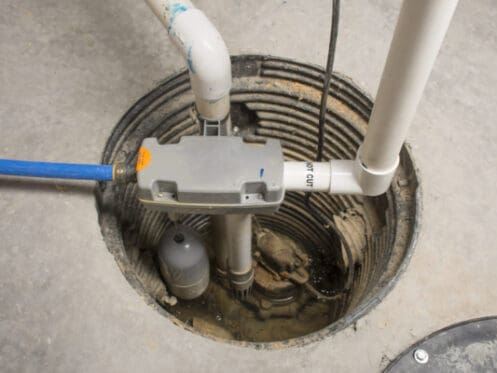A sump pump is an important device to prevent water from flooding basements or crawl spaces by pumping the water out of the area. A sump pump is typically installed in a sump pit, a hole dug in the lowest point of the basement or crawl space. The sump pump is then connected to a drain pipe, which carries the water out of the building and away from the foundation. Installing a sump pump can be a complex process that requires the expertise of a professional plumber or contractor.
Types of Sump Pumps
Not all sump pumps are created equal, and several different types of sump pumps are available on the market.
Pedestal Sump Pump
A pedestal sump pump is a type of pump that sits on a tall pedestal with the motor and impeller located above the sump pit. This design allows for easy access to the pump for maintenance and repair. Pedestal sump pumps are typically less expensive than submersible ones and are best used in low-water basements.
Submersible Sump Pump
A submersible sump pump is a type of pump that’s fully submerged in the sump pit. This design makes the pump more compact and efficient, as it can pump water at a higher rate. Submersible sump pumps are typically more expensive than pedestal sump pumps but are more durable and can handle higher water levels.
Battery-Operated Sump Pump
This type of sump pump is powered by batteries. It is ideal for use in basements where there is no electricity access or as a backup pump in case of power outages.
Water-Powered Sump Pump
A water-powered sump pump is a type of pump powered by water pressure. This type of sump pump is great for use in areas with a reliable source of water pressure, such as a municipal water supply.
Combination Sump Pump
A combination sump pump is a type of sump pump that combines the features of a pedestal and a submersible sump pump. This type of sump pump is ideal for basements with high water levels, as it can pump water at a higher rate than a pedestal sump pump.
Tools and Materials for Sump Pump Installation
Here is a general list of tools and materials that may be needed for a typical sump pump installation:
- Shovel or excavator for digging the sump pit
- Sump pump and check valve
- PVC pipe and fittings for the discharge line
- Electric drill and hole saw
- PVC cement for gluing PVC pipe and fittings together
- Pipe cutter or hacksaw for cutting PVC pipe
- Level
- Bucket or container
- Waterproofing materials
Digging a Sump Pit
A sump pit is a hole dug in a home’s basement to collect water that seeps through the foundation. The collected water is pumped out of the pit and away from the foundation to prevent water damage and flooding. Digging a sump pit is a relatively simple process, but it does require a professional plumber to ensure that the pit is dug in the right location and to the correct depth.
The pit will be located at the lowest point of the basement, typically near the foundation wall. This will ensure that water will collect in the pit and can be easily pumped out. It’s important to note that the sump pit should be located where it can be easily accessed for maintenance and repair by plumbers.
It’s time to start digging. A sump pit typically measures around 24 inches in diameter and around 24 inches deep. A trench is dug around the pit’s perimeter to ensure water can easily flow into the pit. Plumbers will use a level to ensure that the pit is dug to a consistent depth.
Your professional plumber will make the pit’s walls lined with a waterproof membrane to ensure that water does not seep into the surrounding soil. This will also prevent water from seeping into the basement and causing water damage. The membrane will be secured to the pit’s walls with a sealant.
A professional plumber will next install the sump pump. A sump pump is a device that pumps water out of the pit and away from the home’s foundation. The plumber will ensure that the sump pump is properly installed and that all necessary plumbing is in place. The pit will be filled with gravel to ensure that water can easily flow into the pit. The gravel will be packed firmly around the sump pump to ensure stability and security.
Tips for a Smooth Sump Pump Installation
Installing a sump pump can be a complex process, so it should only be handled by a plumber. To ensure that the installation goes smoothly, contact First Choice Plumbing, Heating & Air Conditioning. Our NATE-certified technicians are ready to help you. Here is what they look out for during every sump pump installation job.
The Right Sump Pump
The first step in the sump pump installation is choosing the right pump. As mentioned, several sump pumps are available, including pedestal pumps, submersible, and battery-operated pumps. Each type has advantages and disadvantages, so choosing the one that best suits your needs is important.
The Ideal Location for the Sump Pit
The plumbers will dig the sump pit in the lowest point of the basement or crawl space. This will ensure that the sump pump can efficiently pump out all the water collected in the area. The pit should be deep enough to accommodate the sump pump and allow for the proper discharge of water.
The Best Materials for the Job
The plumbers must use the correct plumbing and electrical materials to ensure that the sump pump is properly connected to the discharge line and power source. PVC pipe and fittings are recommended for the discharge line as they are durable and resistant to corrosion. The sump pump should also be connected to a GFCI-protected outlet to ensure the safety of the users.
The Installation of a Backup Sump Pump
The plumbers can also install a backup sump pump as a precautionary measure in case the primary pump fails. Electricity, batteries, or water pressure can power the backup pump. This will ensure that your basement or crawl space remains dry even in a power outage or primary pump failure.
Testing of the Sump Pump
Once the installation is complete, the plumbers will test the sump pump to ensure it works properly. They will also explain how to maintain the sump pump for optimal performance.
Contact Us
Installing a sump pump requires careful planning and attention to detail. At First Choice Plumbing, Heating & Air Conditioning, we’re prepared to handle the job, no matter how big or small. We serve Metuchen, NJ, as well as the surrounding counties. Our business offers a variety of plumbing services, including sump pumps, toilet repair, water heaters, and repiping. We also handle heating and cooling maintenance, repair, and installation and indoor air quality needs. Contact us today to learn more or to schedule an appointment.



